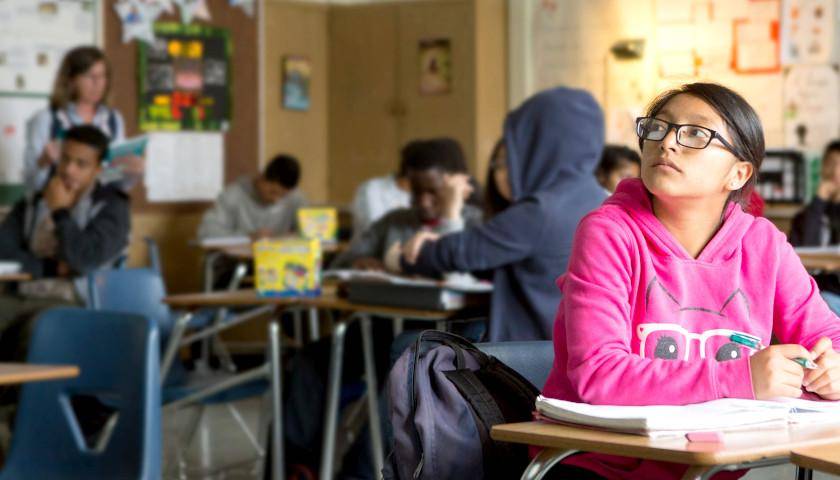by Larry Sand
With “Teacher Appreciation Week” now behind us, it’s crucial that we pay close heed to the well-being of the students, and the news is not good. Gen Z-ers and the newest crop—Generation Alpha—are struggling, and schools are the focal point of the problem.
A new report from Gallup and the Walton Family Foundation surveyed more than 1,000 Gen Z students between the ages of 12 and 18 and found that just 48 percent of those enrolled in middle or high school felt motivated to go to school. Only half said they do something interesting in school every day. On a similar note, a new EdChoice survey reveals that 64 percent of teens said that school is boring, and 30 percent feel that it is a waste of time.
Many students are venting their unhappiness by regularly ditching school. In fact, an estimated 26 percent of public school students were considered chronically absent in 2023, up from 15 percent before the pandemic, per the most recent data compiled by the American Enterprise Institute. Chronic absence is typically defined as missing at least 10 percent of the school year, or about 18 days, for any reason. AEI Senior Fellow Nat Malkus notes that in 33 of 39 states reporting data, chronic absenteeism rates improved in 2023 but still remained 75 percent higher than the pre-pandemic baseline.
According to Malkus, chronic absenteeism is the most critical issue in public schools today. It is projected to significantly impede any efforts to recover from problems incurred during the COVID era. The extended school closures mandated by teacher unions, which prevented in-person instruction, have led to unprecedented and long-lasting learning loss for students.
The AEI report further discloses that students from economically disadvantaged families have been disproportionately affected by chronic absenteeism. However, even in the most affluent districts, chronic absenteeism was nearly twice as high in 2023 as in 2019. Interestingly, the duration of school closures did not significantly influence absenteeism rates. In 2023, chronic absenteeism was at 28 percent for districts that remained closed the longest, only slightly higher than the 25 percent for districts that reopened the fastest.
Many children who do show up at school are acting out as a result of their unhappiness, anxiety, and boredom. District data show that in Los Angeles, violent incidents rose from 2,315 in the 2018-2019 school year to 4,569 in 2022-2023.
Too many K-12 schools pay no mind to the lack of student learning and, instead, blithely graduate many who have no business getting a degree. One of the consequences of this irresponsible practice is that about 40 percent of high school graduates who enroll in college don’t complete their coursework, according to a new report from the National Center for Education Statistics.
The increasing disinterest in post-K-12 education is showing itself in the number of colleges that are shutting down. In fact, per the Hechinger Report, about one college per week on average so far this year has announced that it will close or merge, up from a little more than two a month last year.
The question then becomes, what do we do about this alarming situation? Not surprisingly, the inept government industrial complex fixes are laughable. Here in California, Los Angeles has a plan to reverse their dramatic enrollment decline by recruiting newborns.
Los Angeles schools chief Alberto Carvalho launched a student recruitment campaign in late 2022 targeting newborns in maternity wards, starting with L.A. County-USC Medical Center. His plan is to pitch an L.A. Unified School District education to prospective students’ parents even before babies have left the womb.
In a school system that’s bleeding students—and a further 30 percent decline over the next decade is predicted—the “Born to Learn” campaign is indeed a desperate act. As noted by The Los Angeles Times Howard Blume, “…there’s swag contained in a cheery 8.5-inch cardboard cube with LAUSD-branded gear: a beanie, a onesie, a bib and a plush blanket that Carvalho could not resist referring to as a ‘blankie.'”
One California lawmaker, State Assemblymember Pilar Schiavo, thinks that too much homework is a serious problem and has introduced a bill that would ban teachers from assigning students an “excessive amount” of homework. Schiavo claims that AB 2999, The Healthy Homework Act, would have a “huge impact” on the students. She thinks homework policies need to be constantly reviewed at least once every five years and take into account research available regarding “the impacts of homework on students’ physical and mental health.”
The failing education establishment, notably the teachers’ unions, also insists that higher teacher salaries and more money will solve many student woes. But U.S. News & World Report’s Best States rankings disclose that Florida is the top state for K-12 and higher education in the country. The most recent data on teacher pay, however, shows Florida ranks next to last nationwide and is number 41 of the 50 states in education spending. On the other hand, New York is number two nationally in teacher pay and spends almost three times what Florida does on education, yet only ranks 12th nationally.
The unions, of course, are political entities and disinterested in the welfare of children. In Chicago, where just 15 percent of 8th-grade students are proficient in math and 21 percent are proficient in reading, the Chicago Teachers Union is focused on other things. Internal documents obtained by local news sources reveal that in their new contract proposal, CTU has requested 9 percent annual raises for all teachers, $2,500 retirement bonuses, fully paid abortions for all members, and a load of DEI-inspired featherbed positions at all schools, such as “climate champion,” “restorative justice coordinator,” and “gender support coordinator.” The union is also pushing for housing subsidies for CTU staff and Chicago Public School families, the creation of 180 new sustainable community schools, total teacher autonomy over the curriculum, the implementation of a 100 percent electric bus fleet, a district-wide carbon-neutral mandate by 2035, environmental, social, and governance (ESG) pension investments, weight-loss drug coverage for all members, and $2,000 for each undocumented student. CTU president Stacy Davis Gates proclaims the new contract would cost taxpayers $50 billion.
For real change to happen, parents need to step up. In states that don’t have a private choice program, the best option for parents is to provide education for their kids in the same way they provide food, clothing, and shelter, and indeed, homeschooling rates continue to rise. There were about 3.1 million homeschooled students in 2021-2022 in grades K-12 in the U.S. (roughly 6 percent of school-age children), compared to 2.5 million in spring 2019.
Ronald Reagan once famously quipped, “The nine most terrifying words in the English language are: ‘I’m from the Government, and I’m here to help.'” Too many children are troubled these days, and to turn things around, we must stop looking outside the family for solutions.
– – –
Larry Sand, a former classroom teacher, is the president of the non-profit California Teachers Empowerment Network—a nonpartisan, non-political group dedicated to providing teachers and the general public with reliable and balanced information about professional affiliations and positions on educational issues. The views presented here are strictly his own.
Photo “High School Classroom” by Allison Shelley/The Verbatim Agency for EDUimages . CC BY-NC 2.0.




